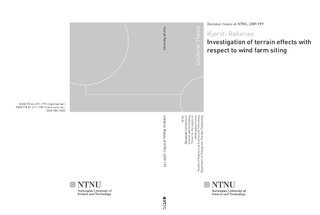| dc.contributor.author | Røkenes, Kjersti | nb_NO |
| dc.date.accessioned | 2014-12-19T11:43:52Z | |
| dc.date.available | 2014-12-19T11:43:52Z | |
| dc.date.created | 2009-12-27 | nb_NO |
| dc.date.issued | 2009 | nb_NO |
| dc.identifier | 283445 | nb_NO |
| dc.identifier.isbn | 978-82-471-1797-2 | nb_NO |
| dc.identifier.isbn | 978-82-471-1798-9 | nb_NO |
| dc.identifier.uri | http://hdl.handle.net/11250/233416 | |
| dc.description.abstract | The turbulent flow above complex and generic terrain has been investigated in a wind tunnel. The objective was to generate a test case for numerical models, and to investigate flow above complex terrain with a view to wind turbine siting. The terrain model was inspired by locations in the mountainous terrain along the Norwegian coastline where wind farms existed or were planned. The model was split up into modules. Some of the modules could be studied both separately and together to cause an even more complex flow. The mean velocity, turbulence intensity and power spectrum in the simulated incoming atmospheric boundary layer was similar to wind in coastal areas. A large number of vertical velocity profiles were measured above the terrain model, using two-component Laser Doppler Anemometry. These were taken in regions where the flow was characterized by velocity speed-up, separation and flow recovery.
The flow above hills with sharp and rounded crests and various inclination angles, followed by a plateau, was compared. Results for a straight slope with a sharp crest was compared to a rounded hill with a similar slope, revealing large discrepancies. Flow above rounded hills was seen to be very advantageous for wind turbines, with increased mean velocities and reduced turbulence intensity, compared to the incoming flow. Separated flow occurred in the case with a sharp crest, resulting in highly increased levels of turbulence. Cases with two mountains of different heights combined were also studied. When the flow separated downstream of the first mountain, the flow above the second was affected to a varying extent, depending on the height of the upstream mountain compared to that downstream. One of the terrain modules was tested with three combinations of two different surface roughnesses in the inflow and on the model. The effect of different roughness in the inflow was seen to disappear only a short distance downstream of the leading edge of the model, and further downstream the flow conditions depended on the model surface roughness only.
The results were compared to several simple estimation methods, and the ESDU method was seen to give results which were in quite good accordance with the experimental data. The experimental results above the complex and generic terrain model has been used as a test case for one flow solver, and it was found to be a demanding test for the numerical tool.
| nb_NO |
| dc.language | eng | nb_NO |
| dc.publisher | Norges teknisk-naturvitenskapelige universitet, Fakultet for ingeniørvitenskap og teknologi, Institutt for energi- og prosessteknikk | nb_NO |
| dc.relation.ispartofseries | Doctoral Theses at NTNU, 1503-8181; 2009:199 | nb_NO |
| dc.title | Investigation of terrain effects with respect to wind farm siting | nb_NO |
| dc.type | Doctoral thesis | nb_NO |
| dc.source.pagenumber | 226 | nb_NO |
| dc.contributor.department | Norges teknisk-naturvitenskapelige universitet, Fakultet for ingeniørvitenskap og teknologi, Institutt for energi- og prosessteknikk | nb_NO |
| dc.description.degree | PhD i energi- og prosessteknikk | nb_NO |
| dc.description.degree | PhD in Energy and Process Engineering | en_GB |

